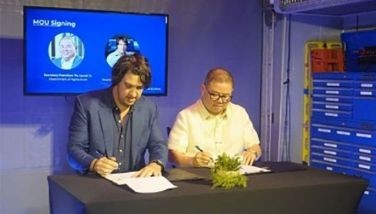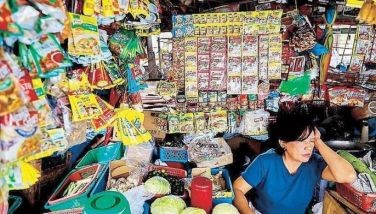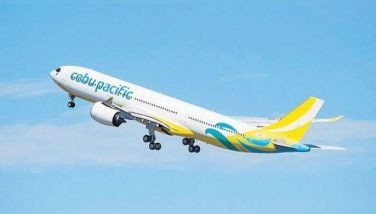Metro Manila’s traffic gridlock – temper blower all year long

The bad flavor of the year is Metro Manila’s traffic gridlock, a personal calvary for those who suffer it daily.
According to a study recently made by JICA (Japan International Cooperation Agency), the current daily cost to the economy of the traffic gridlock is P2.4 billion. If not remedied in time, this would reach P6 billion by 2030.
Presently, when it is not possible to add any expansion of the road system, what can be done to improve the flow of traffic of vehicles in the metropolis? Many measures are implementable, but they are not getting done well.
This is the problem traffic enforcers fail to fulfill. This is the problem of the Metro Manila Metroplitan Commission.
Immediate measures to correct the gridlock. The gridlock of helplessness and indecision on Metro Manila’s problems has lately produced many suggestions to improve traffic flow.
I travel periodically across town from Quezon City to Makati and I understand and experience these problems. What should ideally take no more than 30 minutes could take up to an hour and half during rush hour, even more sometimes.
The remedies being suggested are sensible: encourage the use of fewer vehicles during peak hours, stagger the demand flow for cars by adjusting and staggering schedules for arrivals and dismissals in offices and work places.
Another is the use of special lanes for certain types of vehicles during certain periods. Perennial suggestions to stick to special dedicated lanes for special types of vehicles have their limits. There are not enough lanes.
Also, areas where traffic choke points happen should be given daily attention by traffic policemen. More policemen are needed on the job.
However, let me comment on some proposals and observations, including a few of my own, to understand some promising solutions and their limitations.
The special lanes, including HOV (high occupancy vehicles). The two widest routes, both EDSA and C-5, are quite narrow, only some four to five lanes for each way in general. Where HOV lanes are in the US, the highways are much wider.
The dedication of some available lanes for special use have long been assigned, such as for buses and public utility vehicles. Only recently, special lanes were designated for motorcycles. Since traffic is so thick, the motorcycle lanes are used by four-wheel cars. In the meantime, motorcycle riders are back weaving through traffic, to right, to left, and diagonally.
In the case of HOV lanes for cars, how are we going to deal with tinted vehicles? About a third of motor vehicles are tinted. Such vehicles can easily escape compliance. Is it possible for darkly tinted glassed vehicles to be disallowed from road use to make it fair for all vehicle users?
Schools …. The La Salle-Ateneo high traffic congestion problem. An aspect of the traffic gridlock is the periodic traffic congestion during schooldays in Ortigas Avenue and Katipunan Avenue.
These are high profile examples. There are other schools of the rich that use up the road to create choke points for traffic.
Travellers to Greenhills and Katipunan Avenue where these two schools are located respectively are entrapped by non-moving traffic during the time when students are brought to and picked up from school. The amount of traffic along these roads is astounding. They require effort to look for “neighborly solutions.”
I am more familiar with the Ateneo problem. I get angry all the time when I think that an easy solution is not even at the talking stage. In the case of the Ateneo, all the traffic that enters its gates has to pass through Katipunan Avenue.
Ateneo’s big campus has a long fence across the Marikina side. It is a no-brainer solution to build a gate that passes through the Marikina side, which can connect easily to the Marcos Highway.
It would not take a rocket scientist to plan a road that opens the Marikina side. Ateneo, together with the Marikina city hall and the DPWH, can design a road that diverts traffic to this natural point that connects to the Marikina road and to Marcos Highway.
Parking is a problem that restricts the capacity of the road system to deliver. The use of the public road system for parking of private vehicles is abused badly. There are transient parkers that disrupt traffic because they take up the easement provided by the road. They clog road passages.
There are intransigent violators of parking rules. They park vehicles almost permanently where roads appear available for private appropriation.
There are suspicious accommodations of public spaces (such as those created by underpasses of superhighways, like those in EDSA. (The underpass in the corner of Quezon Avenue and EDSA has been appropriated as a private garage of taxis 24/7.)
There are powerful interests that abuse the system without providing ample parking space for the vehicles of their clients, partners and workers, so the public spaces are clogged.
An example is the clogging of the roads surrounding the ABS-CBN area: Sergeant Esguerra and Mother Ignacia Aves and surrounding area. The enterprise has no public parking space for the vehicles that completely fence off the sidewalks and roads with cars, big utility vehicles, and motorcycles. As a result, pedestrians, at risk for their safety, are left with no option but to walk along the street!
Several offices (government and private) do not plan or provide sufficient parking places. In all cases, both public institutions and private, the need for providing multi-story parking buildings are now essential, because local space is difficult.
The solution implies there is need for investments to be made in parking buildings. Each of these problems needs specific remedies. They require the government to properly regulate the private parking and to remove illegal parkings that reduce road space.
They also require civic and personal sacrifice. In a democracy, the logical and easy solutions are not easily feasible. It takes forceful leadership, proper coordination of the leaders in the general interest. Oftentimes, it is the presence of crisis that helps to open the way for useful solutions. (To be continued)
My email is: [email protected]. Visit this site for more information, feedback and commentary: http://econ.upd.edu.ph/gpsicat/
- Latest
- Trending





























